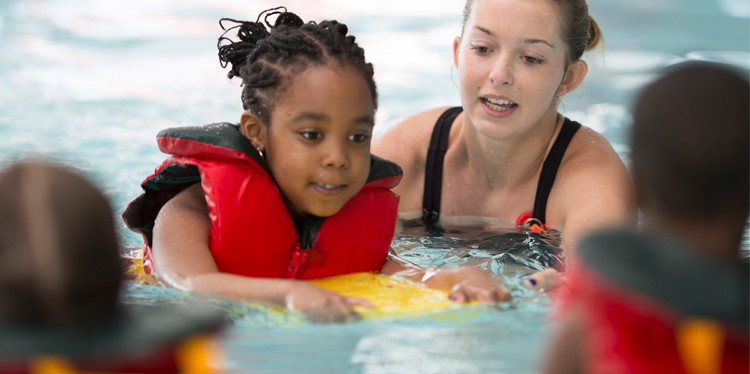Children and water safety

As a Level I pediatric trauma center, our role in the community is not only to care for children who are injured or ill but also to provide education and guidance to prevent injuries. Sadly, despite prevention efforts, drowning remains the leading cause of injury-related death in children four years and younger. Before summer even started this year, we were seeing an unusually high number of pediatric drownings with a disproportionate number of these deaths in children of color. Like too many other health issues, there are significant racial and socioeconomic disparities in drowning rates among children.
As a bystander with a close-up view of the immense pain that accompanies these senseless deaths, I am motivated to prevent families from experiencing such needless suffering. For months now, I have been thinking about the ways I can use my voice to provide education and rally our community resources to prevent another child from drowning. I have no foolproof solution, but there are some major concepts that I want to share here, along with the typical water safety tips.
One incredibly important, protective measure is the recognition of risk associated with water and the underappreciated gift of fear. I am not advocating for scaring our children to the point of preventing them from enjoying a day at the pool or lake, but I am recommending that we explicitly teach about the dangers associated with water so that children don’t enter the water when supervision and safety measures are not present. While this blog post is a good way to spread the word, more public health initiatives highlighting dangers and protective measures would be helpful.
As an example, when my son was three, I recall coaxing him into a pool, by encouraging him to jump to me in the water with a floatation device on. “See, you did it, it’s not that scary!” we all exclaimed as he learned to overcome his natural protective fear of the water. While this seemed to help him engage in swim lessons later that year because he had become comfortable entering the water, I recognize now how dangerous this is, unless it is framed more clearly.
Children need to be taught that they can’t swim without an adult or the floatation device available. A majority of the drownings of young children occur due to unintended access to water during non-swim times. There are multiple failed layers of protection that are discussed when this occurs (supervision, prevented access to water – like fences, and water survival skills), however, if the child did not enter the water due to a healthy fear of the water itself, these other failed layers would be supplemental.
Unfortunately, some children never have a healthy fear of water or any recognition of risk. They are curious and unaware at young ages, or they see other children or families enjoying the water and they assume that they naturally have the same swimming abilities. While providing swimming lessons would seem to be protective in these situations, I am advocating that rather than teaching children to swim, priority should be given to teaching them to survive in the water first.
Swimming will help in most situations and there is evidence that swim lessons may reduce the risk of drowning, but the skill of learning to flip over and float on their back to conserve energy and catch their breath is much more essential for safety. I will stop here to mention that again, this is an area where community engagement and resources are needed to remove barriers of expense and lack of neighborhood pools. Access to swimming and water survival skill lessons should be an equitable opportunity for all children.
Appropriate supervision is the key to safety with most things involving children. To provide this appropriate supervision, the caregiver must recognize the risk and hazards of water. Most supervision lapses seem to be due to other things competing for a supervising adult’s attention, rather than a lack of plan for supervision. When around water it is essential to have someone assigned to watch children in the water. Appropriate supervision is described as “close, constant supervision.” The supervising caregiver should avoid distractions such as phones, other devices, intoxicating substances, and other obligations (meal prep, etc). Children less than four years old are supposed to be within arm’s reach when around water as well, which is an often undervalued recommendation. While adolescents are appropriate caregivers in most situations, additional guidance should be provided to ensure that the risks are understood.
Finally, prohibiting access to water unless under appropriate supervision is another important safety tip. This is easier to enforce with pools, where locks and fencing should be in place that prohibit entrance. With natural bodies of water, prohibiting access can be more of a challenge that requires evaluating the situation and ensuring access points are monitored or barriers are created. Lifeguards are disproportionately present in neighborhoods with more affluence and, thus, are another disparity in this line of defense.
Pediatric drowning is preventable the majority of the time. The preventative measures I described: recognition of risk, survival water skills, dedicated supervision, and no unsupervised access to water are simple measures that protect from this tragedy.
Water safety tips and survival skill resources:
- American Academy of Pediatrics – While staying at home during COVID-19, children’s drowning risk may increase
- HealthyChildren.org – Drowning prevention for curious toddlers
- HealthyChildren.org – Pool dangers and drowning prevention
- Kare11 – Minneapolis Park & Recreation offering free admission, swimming lessons at North Commons Water Park
- Minneapolis Park & Recreation Board – Swimming lessons
About the author
 Dr. Ashley Bjorklund is the Medical Director of Pediatric Critical Care at Hennepin Healthcare. In addition to her clinical care responsibilities, Dr. Bjorklund provides pediatric critical care coverage at Masonic Children’s Hospital, is a member of the Global Pediatrics faculty, and is the UMN Pediatric Critical Care Fellowship Program Director. Her special interests include pediatric critical care in resource-limited settings, care of refugee and immigrant children, utilization of point-of-care ultrasound, medical education, and simulation. Dr. Bjorklund’s family includes husband, Seth, and two energetic kids, Otto and Camille.
Dr. Ashley Bjorklund is the Medical Director of Pediatric Critical Care at Hennepin Healthcare. In addition to her clinical care responsibilities, Dr. Bjorklund provides pediatric critical care coverage at Masonic Children’s Hospital, is a member of the Global Pediatrics faculty, and is the UMN Pediatric Critical Care Fellowship Program Director. Her special interests include pediatric critical care in resource-limited settings, care of refugee and immigrant children, utilization of point-of-care ultrasound, medical education, and simulation. Dr. Bjorklund’s family includes husband, Seth, and two energetic kids, Otto and Camille.

